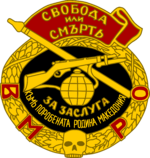Internal Macedonian Revolutionary Organization facts for kids
Quick facts for kids Internal Macedonian Revolutionary Organization |
|
|---|---|
|
|

Emblem of the IMRO
|
|
| Leader(s) | Hristo Tatarchev, Petar Pop-Arsov, Hristo Batandzhiev, Dame Gruev, Ivan Hadzhinikolov, Andon Dimitrov |
| Foundation | 23 October 1893 (4 November N.S.) Thessaloniki, Salonika Vilayet, Ottoman Empire (now Greece) |
| Dissolved | 14 June 1934 |
| Motives | Before WWI: Autonomy for Macedonia and Adrianople regions During WWI: Incorporation of Vardar Macedonia, Belomorie and Pomoravie within Bulgaria After WWI: Independent Macedonia |
| Ideology | Macedonia for the Macedonians |
| Status | Revolutionary Organisation |
| Allies | |
| Opponents | |
| Battles and wars |
|
| Flag |  |
|
|
|
The Internal Macedonian Revolutionary Organization (IMRO) was a secret group. It was formed in the late 1800s in parts of Europe ruled by the Ottoman Empire. Its main goal was to bring change to these areas.
IMRO was founded in 1893 in a city called Salonica. At first, it wanted to gain independence for the regions of Macedonia and Adrianople from the Ottoman Empire. Later, it started to support the interests of Bulgaria in the Balkan region.
Contents
About the IMRO
The IMRO was inspired by an older Bulgarian group called the Internal Revolutionary Organization. It even used their motto, "Freedom or Death." Early members of IMRO were mostly Bulgarians. They used the Bulgarian language in all their documents and letters.
Early Goals and Actions
In 1896, IMRO set up an office in Sofia, Bulgaria. From that year on, they began fighting the Ottomans. They used a fighting style called guerrilla tactics. This means small groups of fighters would make surprise attacks. They were quite successful. In some areas, they even created a kind of "state within a state." This meant they had their own tax collectors and rules.
This fighting grew into a big rebellion in 1903. It was called the Ilinden–Preobrazhenie Uprising. About 15,000 IMRO fighters battled 40,000 Ottoman soldiers.
After the Uprising and World War I
The Ilinden Uprising did not succeed. The Ottomans destroyed about 100 villages. After this, IMRO started using more extreme methods. They sometimes targeted regular people.
During the Balkan Wars and World War I, IMRO helped the Bulgarian army. They worked with Bulgarian authorities when Bulgaria took control of parts of Thrace and Macedonia. At this time, IMRO stopped focusing on independence. Instead, they wanted these areas to become part of Bulgaria.
After World War I and Later Years
After World War I, the revolutionary groups in Macedonia and Thrace split. IMRO became known as a group that used violence. They wanted to change the borders in the Macedonian regions of Greece and Yugoslavia. They disagreed with how Macedonia was divided.
IMRO launched attacks from their base in Petrich, Bulgaria. These attacks went into Greek and Yugoslav lands. A treaty in 1923, called the Treaty of Niš, threatened their base in Bulgaria. In response, IMRO worked with other Bulgarian groups to assassinate the Bulgarian prime minister, Aleksandar Stamboliyski, in 1923.
In 1925, the Greek army tried to stop IMRO's activities. They launched an operation across the border. But the League of Nations stopped them. IMRO's attacks then started again.
In the years between the two World Wars, IMRO also worked with a Croatian group called the Ustaše. Together, they were involved in the assassination of Alexander I of Yugoslavia in France in 1934.
After a change in government in Bulgaria in 1934, the Bulgarian army cracked down on IMRO's base in Petrich. This greatly weakened the organization.
Legacy of IMRO
The IMRO changed its name several times over the years. After communism ended in the region, many political parties claimed to be connected to IMRO. They did this to gain support. For example, in Bulgaria, a party called "VMRO" was formed in the 1990s. In what was then the Republic of Macedonia, a party called "VMRO-DPMNE" was also created.
Images for kids
-
A convoy of captured Bulgarian IMRO activists.
-
IMRO Revolutionaries from Florina, 1903.
-
Sandanski (left in front of flag) with IMARO members supporting Bulgarian troops during Balkan wars.
See also
- Velin Alaykov
- Ivan Anastasov
- Dimitar Andonov
- Aleksandar Andreev
- Ivan Angov
- Bulgarian People's Macedonian-Adrianople Revolutionary Organization
- Internal Macedonian Revolutionary Organization (United)
- Internal Revolutionary Organisation
- Internal Thracian Revolutionary Organisation
- Macedonia (region)
- Macedonian Bulgarians
- Macedonian Question
- Ohrana
- Thrace
- Thracian Bulgarians
- United Macedonia
- March of the Macedonian Revolutionaries
- Flags of Internal Macedonian-Adrianople Revolutionary Organization
Note



















